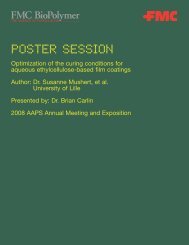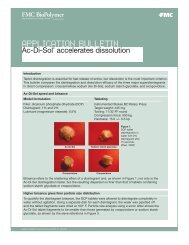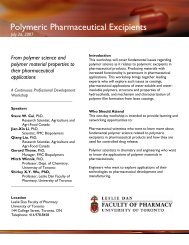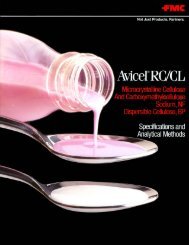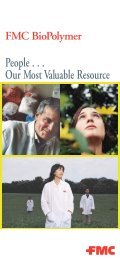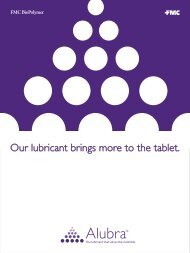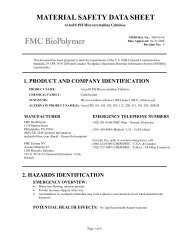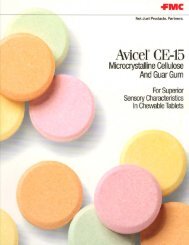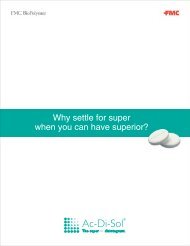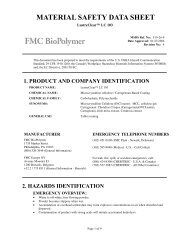Avicel® HFE-102 - FMC BioPolymer
Avicel® HFE-102 - FMC BioPolymer
Avicel® HFE-102 - FMC BioPolymer
You also want an ePaper? Increase the reach of your titles
YUMPU automatically turns print PDFs into web optimized ePapers that Google loves.
MATERIAL SAFETY DATA SHEET<strong>Avicel®</strong> <strong>HFE</strong>-<strong>102</strong>MSDS Ref. No.: <strong>HFE</strong>-M10DR050Date Approved: 01/10/2008Revision No.: 5This document has been prepared to meet the requirements of the U.S. OSHA Hazard CommunicationStandard, 29 CFR 1910.1200; the Canada’s Workplace Hazardous Materials Information System (WHMIS)and, the EC Directive, 2001/58/EC.1. PRODUCT AND COMPANY IDENTIFICATIONPRODUCT NAME:CHEMICAL FAMILY:SYNONYMS:GENERAL USE:<strong>Avicel®</strong> <strong>HFE</strong>-<strong>102</strong>CarbohydrateMicrocrystalline cellulose (INCI name): MCC, cellulose gel;Mannitol: D-Mannitol, Manna sugar, 1,2,3,4,5,6-HexanehexolPharmaceutical ExcipientMANUFACTURER<strong>FMC</strong> <strong>BioPolymer</strong>1735 Market StreetPhiladelphia, PA 19103(800) 526-3649 (General Information)msdsinfo@fmc.com (Email - General Information)<strong>FMC</strong> Europe NVAvenue Mounier 831200 Brussels, Belgium353 21 435 4133 (General Information - Cork,Ireland)EMERGENCY TELEPHONE NUMBERS(302) 451-0100 (<strong>FMC</strong> Plant - Newark, Delaware)(303) 595-9048 (Medical - U.S. - Call Collect)For leak, fire, spill, or accident emergencies, call:(800) 424-9300 (CHEMTREC - U.S.A. & Canada)(703) 527-3887 (CHEMTREC - Collect - All Other Countries)2. HAZARDS IDENTIFICATIONEMERGENCY OVERVIEW:• White free-flowing, odorless powder.• Powder becomes slippery when wet.• Accumulation of overhead settled dust may form explosive concentrations in air when disturbed anddispersed.POTENTIAL HEALTH EFFECTS: No significant health hazard expected.Page 1 of 9
<strong>Avicel®</strong> <strong>HFE</strong>-<strong>102</strong> (<strong>HFE</strong>-M10DR050) Date: 01/10/20083. COMPOSITION / INFORMATION ON INGREDIENTSChemical Name CAS# Wt.% EC No. EC ClassMicrocrystalline cellulose 9004-34-6 232-674-9 Not ClassifiedMannitol 69-65-8 200-711-8 Not classified4. FIRST AID MEASURESEYES: Flush with plenty of water. Get medical attention if irritation occurs and persists.SKIN: Wash with plenty of soap and water.INGESTION: Drink plenty of water. Never give anything by mouth to an unconscious person. If anydiscomfort persists, obtain medical attention.INHALATION: Remove to fresh air. If breathing difficulty or discomfort occurs and persists, obtainmedical attention.NOTES TO MEDICAL DOCTOR: This product is expected to have low oral, dermal andinhalation toxicity. It is expected to be non-irritating to the eyes and skin, and non-sensitizing to the skin.Treatment is symptomatic and supportive.5. FIRE FIGHTING MEASURESEXTINGUISHING MEDIA: WaterFIRE / EXPLOSION HAZARDS: The accumulation of excessive dust on overheadstructures may produce explosive concentrations when disturbed and dispersed. According to NFPA 68,(Explosion Venting Guide), the Hazard Class of Dust Deflagrations for microcrystalline cellulose is St-1,the lowest hazard class.FIRE FIGHTING PROCEDURES: For fires involving this material, do not enter anyenclosed or confined fire space without wearing full protective clothing and self-contained breathingapparatus (SCBA) approved for firefighting. This is necessary to protect against the hazards of heat,products of combustion and oxygen deficiency. Do not breathe smoke, gases or vapors generated.Page 2 of 9
<strong>Avicel®</strong> <strong>HFE</strong>-<strong>102</strong> (<strong>HFE</strong>-M10DR050) Date: 01/10/2008FLAMMABLE LIMITS: Not applicable6. ACCIDENTAL RELEASE MEASURESRELEASE NOTES: Powder becomes slippery when wet. Maintain good housekeeping practicesto minimize accumulation of settled dust, especially on overhead surfaces. Sweep up the spilled materialand dispose of in accordance with the waste disposal method outlined in Section 13, "DisposalConsiderations".7. HANDLING AND STORAGEHANDLING AND STORAGE: Use local exhaust or general dilution ventilation to controlexposure to dust. Always use safe lifting techniques when manually moving containers, especially whenshipping containers weighing more than 50 pounds (22.7 kg). To protect quality, store in a tight container ina dry place, at room temperature (approximately 25°C). Pallets should be stacked in a stable manner.Maintain adequate clearance from structural members and sprinklers; NFPA and U.S. OSHA state aminimum of 18 inches (45.7 cm) clearance shall be maintained between the top of storage and the ceilingsprinkler deflectors.8. EXPOSURE CONTROLS / PERSONAL PROTECTIONEXPOSURE LIMITSChemical Name ACGIH OSHA SupplierMicrocrystallinecellulose10 mg/m 3 (TWA) 15 mg/m 3 (PEL) (totaldust)5 mg/m 3 (PEL)(respirable fraction ofdust)PERSONAL PROTECTIVE EQUIPMENTEYES AND FACE: Whenever airborne dust concentrations are high, appropriateprotective eyewear, such as mono-goggles, should be worn to prevent eye contact.RESPIRATORY: Whenever dust in the worker's breathing zone cannot be controlled withventilation or other engineering means, workers should wear respirators or dust masks approved byNIOSH/MSHA, EU CEN or comparable certification organization to protect them against airbornedust.PROTECTIVE CLOTHING: No special clothing is required.GLOVES: No special gloves are required.Page 3 of 9
<strong>Avicel®</strong> <strong>HFE</strong>-<strong>102</strong> (<strong>HFE</strong>-M10DR050) Date: 01/10/2008COMMENTS:ADDITIONAL EXPOSURE LIMITS:MCC:Australia (TWA) 10 mg/m³Belgium (TWA) 10 mg/m 3 (inhalable dust)China (STEL): 25 mg/m³China (TWA): 10 mg/m³Hong Kong (TWA): 10 mg/m³Ireland (TWA): 10 mg/m³ (inhalable dust)Korea (TWA): 10 mg/m³New Zealand (TWA): 10 mg/m³ (respirable dust with no asbestos and less than 1% free silica)Singapore (PEL): 10 mg/m³Switzerland (TWA): 3 mg/m³ (respirable dust)United Kingdom (STEL): 10 mg/m³ (total inhalable dust)United Kingdom (TWA): 10 mg/m³ (total inhalable dust); 4 mg/m³ (respirable dust)9. PHYSICAL AND CHEMICAL PROPERTIESODOR:OdorlessAPPEARANCE:White, free-flowing powderAUTOIGNITION TEMPERATURE: Not applicableBOILING POINT:Not applicableCOEFFICIENT OF OIL / WATER: (Kow) Not applicableEVAPORATION RATE:(Butyl acetate = 1) Not applicableFLASH POINT:Not applicableMELTING POINT:Not applicableOXIDIZING PROPERTIES:Not applicablePERCENT VOLATILE:Typically 1 - 5 % water, by weightpH:(In solution) 5.0 - 7.0 (11% solids dispersion)SOLUBILITY IN WATER:(% by weight) InsolubleSPECIFIC GRAVITY:(H 2 O = 1) Bulk density, 0.2 - 0.5 g/ccVAPOR DENSITY:(Air = 1) Not applicableVAPOR PRESSURE:Not applicableCOMMENTS:EXPLOSIVE PROPERTIES: Microcrystalline cellulose: St-1MINIMUM IGNITION TEMPERATURE: Microcrystalline cellulose: 420°CPage 4 of 9
<strong>Avicel®</strong> <strong>HFE</strong>-<strong>102</strong> (<strong>HFE</strong>-M10DR050) Date: 01/10/200810. STABILITY AND REACTIVITYCONDITIONS TO AVOID:STABILITY:HAZARDOUS DECOMPOSITION PRODUCTS:None knownStableNone known.11. TOXICOLOGICAL INFORMATIONEYE EFFECTS: No data available for the formulation.MCC: Non-irritating (rabbit)SKIN EFFECTS: No data available for the formulation.MCC: Non-irritating (PII = 0/8.0) (rabbit)DERMAL LD 50 : No data available for the formulation.MCC: > 2,000 mg/kg (rabbit)ORAL LD 50 : No data available for the formulation.MCC: > 5,000 mg/kg (rat)Mannitol: 13,500 mg/kg (rat); 22,000 mg/kg (mouse)INHALATION LC 50 : No data available for the formulation.MCC: > 5.05 mg/l (4 h) (rat) Maximum attainable concentration - zero mortalitySENSITIZATION: No data available for the formulation.MCC: (Skin) Non-sensitizing (guinea pig)ACUTE EFFECTS FROM OVEREXPOSURE: This product is expected to have loworal, dermal and inhalation toxicity. It is expected to be non-irritating to the eyes and skin, and nonsensitizingto the skin. Headaches, nausea, vomiting, chills, dizziness, polydipsia, lethargy, confusion andsensation of constriction or pain in the chest have been observed following infusion of mannitol. Fatalitieshave occurred after large doses. Common effects of large doses of mannitol include dehydration, massivediuresis, and acute increase in intravascular volume, resulting in congestive heart failure or intracranialhemorrhage.CHRONIC EFFECTS FROM OVEREXPOSURE: No data available for theformulation. Microcrystalline cellulose is considered an inert dust, which is not toxic to the lung whenexposures are properly controlled. A 90-day animal study showed no adverse effects when administered inthe diet. Microcrystalline cellulose was negative in the Ames mutagenicity assay, and caused nochromosome damage in the mouse micronucleus assay. No adverse human effects are known. In studieswith laboratory animals, using 98 - 100% pure D-mannitol, the National Toxicology Program (NTP) hasconcluded that D-mannitol was not carcinogenic.Page 5 of 9
<strong>Avicel®</strong> <strong>HFE</strong>-<strong>102</strong> (<strong>HFE</strong>-M10DR050) Date: 01/10/2008CARCINOGENICITY:NTP:Not listedIARC:Not listedOSHA:Not listedOTHER:Not Listed (ACGIH)12. ECOLOGICAL INFORMATIONENVIRONMENTAL DATA: No data available for the formulation.Microcrystalline cellulose is inherently biodegradable in soil. It biodegrades in soil at a rate comparable tocorn starch.D-Mannitol is not expected to undergo hydrolysis in the environment due to the lack of hydrolyzablefunctional groups, nor to directly photolyze due to the lack of absorption in the environmental UVspectrum. An estimated BCF of 1 was calculated for D-mannitol, suggesting that the potential forbioconcentration in aquatic organisms is low. The Koc of D-mannitol is estimated as approximately 5,suggesting that it is expected to have very high mobility in soil.ECOTOXICOLOGICAL INFORMATION: No data available for the formulation.MCC:48-hour LC 50 > 100%, saturated solution, NOEC = 100% (daphnia)96-hour LC 50 > 100%, saturated solution, NOEC =100% (rainbow trout)96-hour EC 50 > 100%, saturated solution, NOEC = 12.5% (algae)13. DISPOSAL CONSIDERATIONSDISPOSAL METHOD: No special disposal methods are suggested. It is the user's responsibilityto comply with all applicable local, state, and federal laws, rules, regulations and standards.14. TRANSPORT INFORMATIONU.S. DEPARTMENT OF TRANSPORTATION (DOT)MARINE POLLUTANT:ADDITIONAL INFORMATION:NoneNot listed in Title 49 of the U.S. Code ofFederal Regulations as a hazardousmaterial.Page 6 of 9
<strong>Avicel®</strong> <strong>HFE</strong>-<strong>102</strong> (<strong>HFE</strong>-M10DR050) Date: 01/10/2008ADDITIONAL INFORMATION:National Motor Freight Classification Item71390, Flour Cellulose, EdibleINTERNATIONAL MARITIME DANGEROUS GOODS (IMDG)ADDITIONAL INFORMATION:Not applicableADR - EUROPEAN AGREEMENT CONCERNING THEINTERNATIONAL CARRIAGE OF DANGEROUS GOODS BY ROADADDITIONAL INFORMATION:Not applicableINTERNATIONAL CIVIL AVIATION ORGANIZATION (ICAO) /INTERNATIONAL AIR TRANSPORT ASSOCIATION (IATA)ADDITIONAL INFORMATION:Not applicableOTHER INFORMATION:Canada (TDG) : Not applicable15. REGULATORY INFORMATIONUNITED STATESSARA TITLE III (SUPERFUND AMENDMENTS AND REAUTHORIZATION ACT)SECTION 302 EXTREMELY HAZARDOUS SUBSTANCES (40 CFR 355, APPENDIX A):Not applicableSECTION 311 HAZARD CATEGORIES (40 CFR 370):NoneSECTION 312 THRESHOLD PLANNING QUANTITY (40 CFR 370):The Threshold Planning Quantity (TPQ) for this product, if treated as a mixture, is 10,000 lbs;however, this product contains the following ingredients with a TPQ of less than 10,000 lbs.:NonePage 7 of 9
<strong>Avicel®</strong> <strong>HFE</strong>-<strong>102</strong> (<strong>HFE</strong>-M10DR050) Date: 01/10/2008SECTION 313 REPORTABLE INGREDIENTS (40 CFR 372):This product does not contain any toxic chemicals subject to the reporting requirements ofSection 313, Title III of the SARA (Superfund Amendments and Reauthorization Act) of1986.CERCLA (COMPREHENSIVE ENVIRONMENTAL RESPONSE COMPENSATION ANDLIABILITY ACT)CERCLA DESIGNATION & REPORTABLE QUANTITIES (RQ) (40 CFR 302.4):Not applicableTSCA (TOXIC SUBSTANCE CONTROL ACT)TSCA INVENTORY STATUS (40 CFR 710):ListedCANADAWHMIS (WORKPLACE HAZARDOUS MATERIALS INFORMATION SYSTEM):Not a controlled product under the Canadian Workplace Hazardous Materials Information System(WHMIS).Domestic Substance List:ListedE NUMBERS:E 460(i) (microcrystalline cellulose)E 421 (mannitol)INTERNATIONAL LISTINGSMCCAustralia (AICS): ListedChina: ListedJapan (ENCS): (8)-568Korea: KE-05339Philippines (PICCS): ListedMannitolAustralia (AICS): ListedChina: ListedJapan (ENCS): (8)-49; (9)-1375Korea: KE-23061Philippines (PICCS): Listed16. OTHER INFORMATIONPage 8 of 9
<strong>Avicel®</strong> <strong>HFE</strong>-<strong>102</strong> (<strong>HFE</strong>-M10DR050) Date: 01/10/2008NFPAHealth 0Flammability 1Reactivity 0SpecialNoneNo special requirementsNFPA (National Fire Protection Association)Degree of Hazard Code:4 = Extreme3 = High2 = Moderate1 = Slight0 = InsignificantREVISION SUMMARY:This MSDS replaces Revision #4, dated January 8, 2008.Changes in information are as follows:Section 1 (Product and Company Identification)Section 16 (Other Information)Avicel and <strong>FMC</strong> <strong>BioPolymer</strong> - Trademarks of <strong>FMC</strong> Corporation© 2008 <strong>FMC</strong> Corporation. All Rights Reserved.Page 9 of 9




